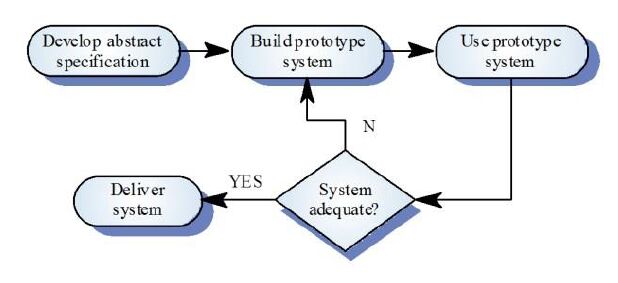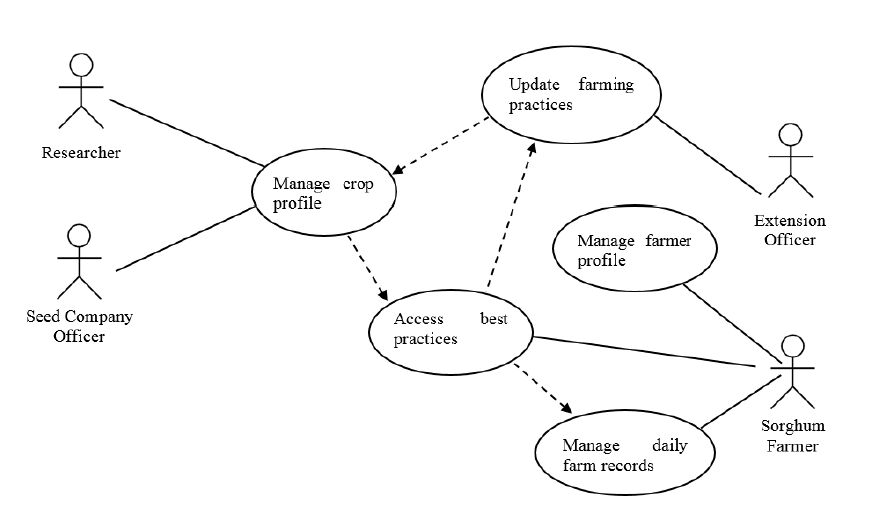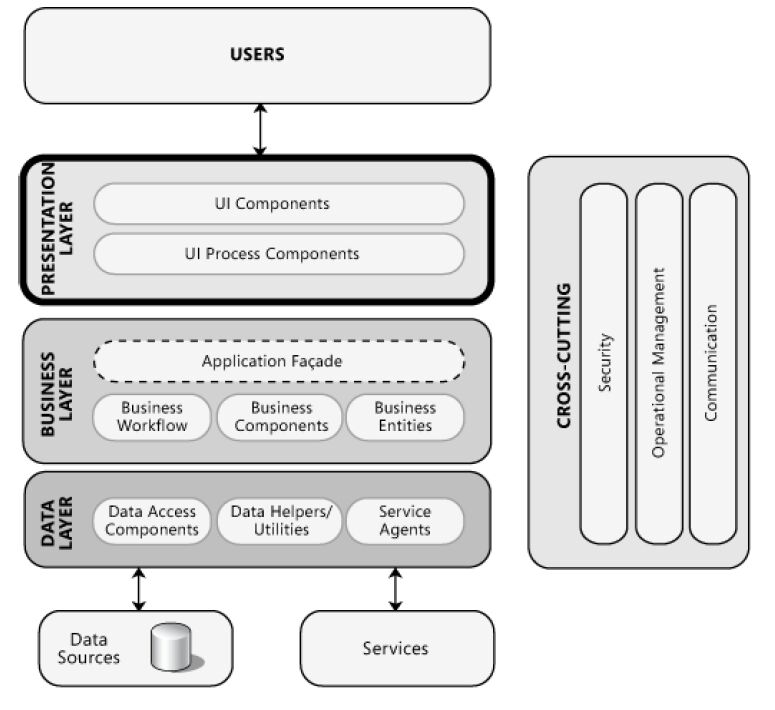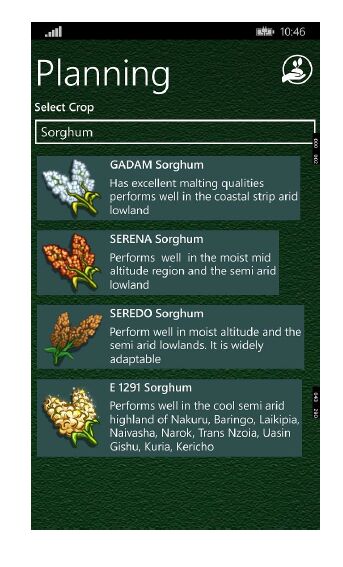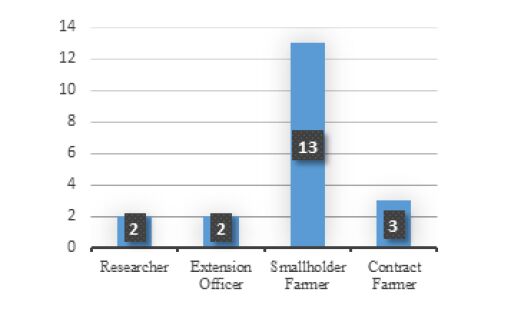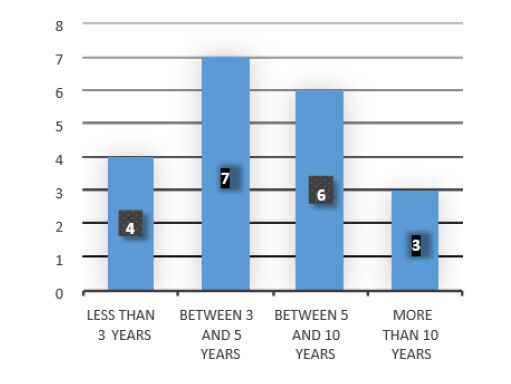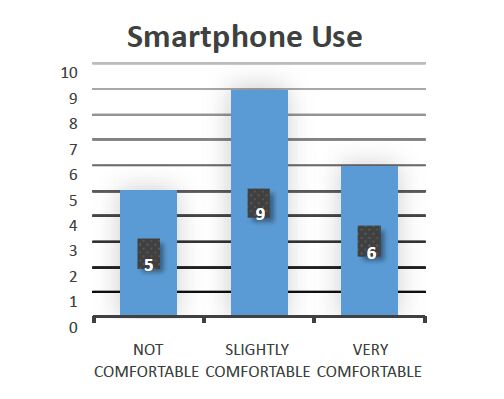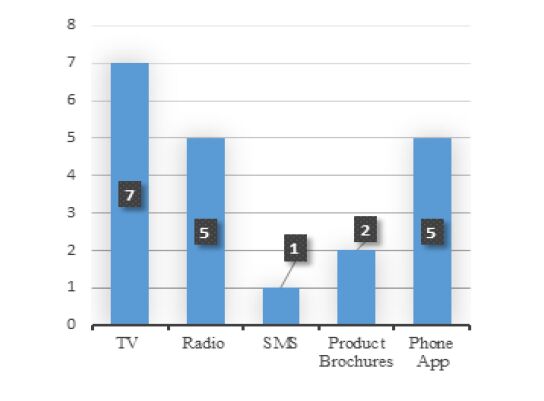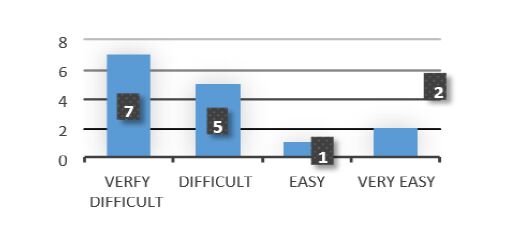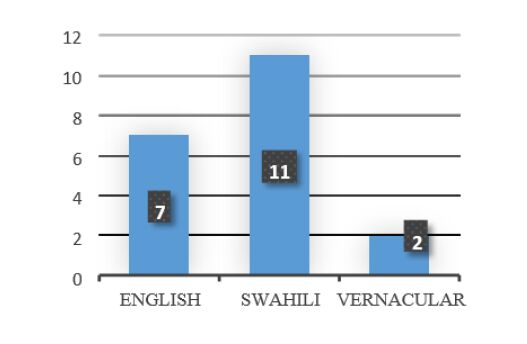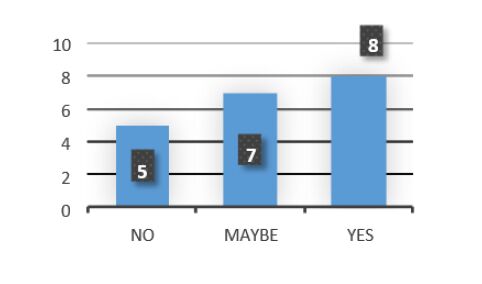Recent researches have shown that a food security strategy that dependent entirely on exotic crops, which are greatly affected by sporadic rainfall, is not sustainable. There is a need to shift to indigenous crops that are more tolerant to unpredictable weather patterns. Little shareable knowledge exists on the production of these crops; the production knowledge is passed by word of mouth and demonstration across generations, and sometimes lost in the process. This research seeks to show how this gap can be addressed using a knowledge management system (KMS). One of the key factors that distinguishes the intelligent production process of the 21st century is the emphasis on data, information and ultimately knowledge. The importance of KMS in agriculture cannot be over emphasized. This research started with an exploratory pre-study to identify the key functionality that needed to be captured by the KMS. The pre-study brought to the fore the need for the use of technology information in improving the sorghum production process. Three key themes emerged from the pre-study, namely identification of best practices, convenient way of disseminating information to stakeholders, and finally enhancement of research processes through use of information technology. These functional needs formed the basis for the development of the KMS. Further works can be undertaken to expand the solution to include more weather tolerant crops patterns, in order to provide a wider crops option to smallholder farmers.
1.
Introduction
Sesame is one of the most important oily seeds. India, China, Sudan and Mexico account for about 60% of the annual production of this product [1]. China is the largest sesame producer in the world. Sesame seeds have the highest oil content among other oily seeds, but it is much less produced than other seeds such as soybeans, sunflowers in Iran. Sesame oil is known as a high quality oil [2]. This oil has the highest resistance and durability among edible oils with a high percentage of unsaturated fat. The natural antioxidants in this oil have a high resistance to oxidation and valuable physiological properties of sesame oil [3]. The amount of present oil in its grain is about 50%. Its fatty acid composition contains 70% unsaturated fatty acids, such as linoleic acid, oleic acid, and some saturated fatty acids such as palmitic and arachidic acids [4]. Sesame oil is one of the unsaturated oils and it is beneficial to humans and it has been proven that this oil can lower human cholesterol levels. Sesame oil does not fume because of its high resistance to heat, does not foam, does not change color and does not produce unpleasant smell in the kitchen. Hence, it is very good for human that cook foods with sesame oil. The sweet smell and taste of the desirable characteristics of sesame oil is considered as a natural salad oil, and also has a low freezing point [5].
Adulteration and quality can be considered as a set of attributes that combine them from a consumer perspective to lead to product acceptance [6]. The basis of qualitative assessments is mainly mental, and attributes such as color, appearance and taste in food are examined by sensory judges [7]. Since human perception is easily misunderstood, such assessments, in addition to high costs, do not have the necessary stability, hence it is necessary for objective and inescapable evaluation systems [8]. Recently computer-based assessment systems have been used for authentication in food industries, considerably [9].
The main method of misuse is the mixing of vegetable oils, canola oil and corn oil with pure sesame oil. It is also not possible to detect these adulterated oils. Accordingly, the development of a new method that can overcome existing problems, with advantages such as high accuracy and low processing time, is very necessary [10]. In this regard, an image processing technique can be used. This technique has been applied to different crops and agriculture.
In recent years, there has been a lot of research in the field of cheating various oils. Marshall et al. (2013) performed a study to detect the content of oil impurities. Their aim was to develop a device that could detect adulteration in the olive oil by the visual machine and artificial neural network. In this research, color photographs are used that uses the histogram of red, green and blue (RGB) colors by counting the number of pixels at each level of intensity (256 levels of intensity). These three histograms were combined together and a total of 768 cells were obtained, with the number of pixels in each cell being considered as the input of the neural network. They reported that trained neural networks can distinguish between virgin oils and gross oils that are considered adulteration with an accuracy of 88.36% [11].
Regarding the cases mentioned briefly in relation to edible oils, it can be argued that detection of adulteration and the estimation of impurities is one of the necessities for improving the quality level and increasing the competitiveness of this product in national and international markets. Therefore, the use of a novel method to detect the adulteration of sesame oil can be very useful and effective. Therefore, the main goal of this study is to evaluate a portable system for detecting oil fraud by integrating the machine vision technology. In order to extract color properties in this study, the average color components of RGB, CMY and L * A * B* have been used.
2.
Materials and methods
2.1. Samples
Sesame oil samples were prepared from Khorramshahr oil company and produced at Manjil Ghonje Rudbar Oil Plant. Sesame oil image processing experiments began one day after the specimen was prepared. After preparing the samples, they were mixed with different proportions (50 to 95%) with sunflower oil. It should be noted that in these six samples, the first sample has 5% mixing, and the next samples raised as a dozen. Separate mixtures of sesame oil and sunflower oil were prepared in percentages of 50-50, 60-40, 70-30, 80-20, 90-10, and 95-5. In the following, a similar operation was performed for canola oil. Then from each of the samples, sesame oil, sunflower oil and canola were prepared as 100%. The specimens were then poured into a cylindrical container and each analyzed separately.
2.2. Image processing
For the purpose of taking pictures, the chamber whose walls was covered with black cloth was used to prevent the reflection of light in space and to prevent oscillation in the image. One fluorescent lamp was used to create light. The Sony CCD camera has 480 television line (TVs) and 492 x 510 pixels. To diagnose the mixing of sesame oil with other oils, it needs total color; therefore, the camera is mounted vertically above the capacitive sensor to provide an image above the oil and to process image processing and color extraction. The camera is also positioned at a distance of 20 cm from the oil level. The Pin Avid USB 2.0 imaging card was also used to communicate between the camera and the computer. The features of this card are clearly 5720 × 720 and the speed of imprinting is 25 frames per second and evaluation of image processing in the MATLAB 2018 was done. Color channels were used for calculations, and the color properties of the RGB and lab channels were extracted on the final color image.In this research, 2 × 6 features were obtained for each image. Then, from each color channel, two statistical characteristics including Skewness and Kurtosis were extracted and finally, 12 features variables could show the color variations of the soil samples.
2.3. Artificial neural network (ANN)
An artificial neural network is a smart way to process information that is inspired by the biomedical nervous system and deals with the processing of information like the brain [12]. Artificial neural networks (ANNs) are one of the subcategories of artificial intelligence (AI) science that is widely used in data analysis and modeling. Various types of ANNs have been developed [13]. Multilayer perceptron (MLP) is commonly used for classification and function approximation purposes.Input layer, hidden layer (s) and output layer constitute the MLP structure. MLP is a feed-forward neural network (FFNN), meaning that the data flows in one direction from input layer to output. Error minimization can be performed by gradient descent with momentum (GDM), this method was used to classify different classes of oil.
In order to extract color properties, artificial neural networks with a hidden layer with a number of different neurons (from 1 to 20) were designed and evaluated.
3.
Results and discussion
In this section, the color properties of oil samples were extracted and artificial neural network method was used to determine the concentration. The results of the neural network prediction are also given below. The artificial neural network used in this study was used to determine the concentration of different oil samples with single layer structure and LM algorithm. Also, in this research 70% of the data was used for network training, 15% for validation and 15% for network testing. Figure 1 shows the amount of R (correlation coefficient) from the single-layer neural network with the number of neurons between 1 and 20 for sesame -sunflower oil samples and sesame-canola samples.
As shown in Figure 1 and Figure 2, a single-layer neural network and the LM algorithm have a very good performance in concentration estimation. According to Figure1, the lowest and highest correlation coefficient was found to be 0.61425 (20 neurons) and 0.9772 (6 neurons) respectively. Also, in correlation coefficient of sesame-canola oil, the lowest correlation coefficient was observed with the value of 0.6094 (16 neurons) and the highest value was 0.9719 (10 neuron).
In the available data, the smallest and largest R is 0.0003 (6 neurons) and 0.0028 (20 neurons). Also, in the forms obtained from the mixture of oils of canola, the smallest error referring to the number of neurons 10 and the highest number of neuron numbers 16 was 0.0019 and 0.0098, respectively. As a result, the best topology for sesame oil is sunflower 12-6-7 and for sesame oil-canola 12-10-7 (Figure 3).
To evaluate performance of models and to select the best ones, three different statistical indicators were applied. These indicators were sensitivity (Se), specificity (Sp), and accuracy (Ac). The statistical indicators can be defined mathematically as follows:
where the TP, TN, FP, and FN are the numbers of true positives, true negatives, false positives, and false negatives, respectively.
Table 1 and Table 2 show the indicators of sensitivity (Se), specificity (Sp), and accuracy (Ac) for Sesame-Sunflower and Sesame-Canola samples, respectively. According to the results, the obtained data from the Sesame-Sunflower were evaluated more accurately than the data of Sesame-Canola. Also, the highest precision was related to oils S100 (sunflower oil) and C100 (canola oil) and the least in both categories was related to the sample containing 10% of the adulterated oil.
4.
Conclusion
Sesame oil is one of the most expensive oils because of its high advantages. As a result, some salespersons are encouraged to mix low-cost oils such as canola and sunflower with sesame oil to reach more profit. There are different laboratory methods for determining the quality of sesame oil, which are mostly destructive. In this research, a non-destructive image processing technique was used to estimate the quality of sesame oil. Nowadays, machine vision has made a significant progress in the food industry. Another benefit of the machine vision is its low cost compared to some laboratory methods. Of course, the use of the image processing technique is limited in determining the quality of liquids due to the lack of uniformity of light diffusion. After image acquisition and image processing in different color channels, for data analysis artificial neural network (ANN) was used. It should be noted that sesame -sunflower oil and sesame -canola oil were tested and evaluated separately. In the use of artificial neural network, the number of different neurons was used and the best results were reported. According to the obtained statistical indexes, it can be concluded that image processing techniques and artificial neural network have able to estimate the quality of sesame oil.
Acknowledgements
The authors would like to Machine design and Mechatronics Department, Institute of Mechanics, Iranian Research Organization for Science and Technology for their contributions to this study.
Conflict of interest
The authors declare no conflicts of interest in this paper.










 DownLoad:
DownLoad:




